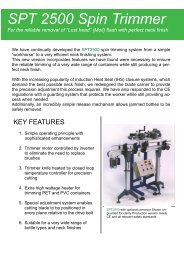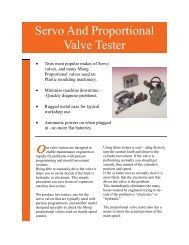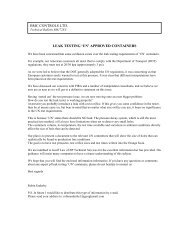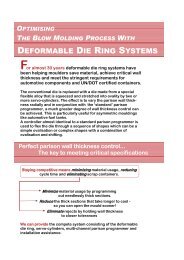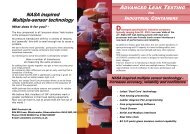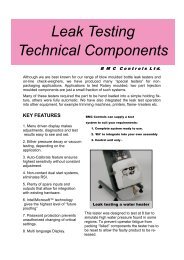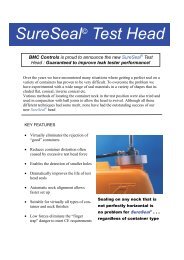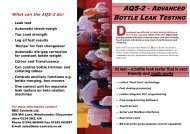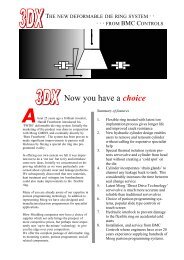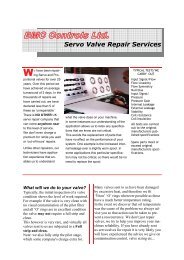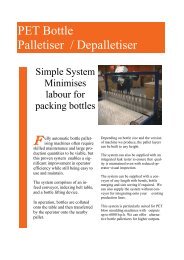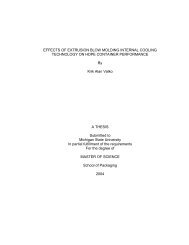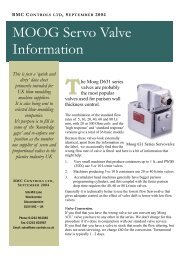Troubleshooting: Blow Molding Get a Handle on Stress-Cracking In ...
Troubleshooting: Blow Molding Get a Handle on Stress-Cracking In ...
Troubleshooting: Blow Molding Get a Handle on Stress-Cracking In ...
Create successful ePaper yourself
Turn your PDF publications into a flip-book with our unique Google optimized e-Paper software.
PT Home<br />
Research Z<strong>on</strong>es<br />
Suppliers<br />
Materials DataCenter<br />
Machinery Database<br />
Articles<br />
Resin Prices<br />
Subscribe<br />
<str<strong>on</strong>g>Troubleshooting</str<strong>on</strong>g>: <str<strong>on</strong>g>Blow</str<strong>on</strong>g> <str<strong>on</strong>g>Molding</str<strong>on</strong>g><br />
<str<strong>on</strong>g>Get</str<strong>on</strong>g> a <str<strong>on</strong>g>Handle</str<strong>on</strong>g> <strong>on</strong> <strong>Stress</strong>-<strong>Cracking</strong> <strong>In</strong> HDPE Bottles<br />
Print This Article<br />
By Robert DeL<strong>on</strong>g, Blasformen C<strong>on</strong>sulting<br />
One of the first applicati<strong>on</strong>s for blow molded HDPE bottles was the replacement of glass for bleach<br />
packaging. A standing joke am<strong>on</strong>g the bottlers was that their bottles <strong>on</strong>ly cracked in the summertime,<br />
usually <strong>on</strong> the back seat of a Cadillac, and next to a fur coat being taken in for storage. All joking aside, the<br />
potential for envir<strong>on</strong>mental stress cracking (ESCR) of HDPE bottles has always existed because of the<br />
material’s inherent semi-crystalline characteristics. The most comm<strong>on</strong> victims are HDPE c<strong>on</strong>tainers for liquid<br />
detergents, motor oil, and industrial chemicals. The phenomen<strong>on</strong> occurs regardless of the size of the<br />
c<strong>on</strong>tainer—even large IBC c<strong>on</strong>tainers for similar liquids can be susceptible.<br />
Learn More<br />
Visit the<br />
<str<strong>on</strong>g>Blow</str<strong>on</strong>g> <str<strong>on</strong>g>Molding</str<strong>on</strong>g> Z<strong>on</strong>e<br />
<strong>In</strong> the summer, ESCR problems are exacerbated due to several factors related to increased heat and humidity. Processors need to be acquainted<br />
with these sources of stress and the testing opti<strong>on</strong>s. Some countermeasures are available to deal with this age-old problem.
ESCR TEST LIMITATIONS<br />
<strong>In</strong> the 1930s, Western Electric was an early adopter of LDPE as a replacement for lead sheathing <strong>on</strong><br />
multi-pair teleph<strong>on</strong>e cables. Before l<strong>on</strong>g, in-service cracking of the cable jacket was noted. Western<br />
Electric’s R&D department, known as Bell Laboratories, devised a test for ESCR. <strong>In</strong>formally known as<br />
Fig. 1—A classic example of stresscracking<br />
in HDPE c<strong>on</strong>tainers is found at<br />
the end of the pinch-off eye.<br />
the Bell Lab test, this test method is today called ASTM D1693. Ten 0.5 x 2 in. specimens are die-cut from a 0.125-in. compressi<strong>on</strong> molded<br />
plaque. These are scribed with a 0.010-in.-deep imperfecti<strong>on</strong> and then are bent into a “U” shape and inserted into a channel, notch-side out. The<br />
holder with the 10 specimens is inserted into a test tube filled with Igepal 630 surfactant and placed in a 122 F bath. As each specimen cracks,<br />
the time is plotted. F0 is the number of hours until the first <strong>on</strong>e cracks, F50 is when half have cracked, and F100 is when the last <strong>on</strong>e breaks.<br />
<strong>In</strong> the early 1950s, new and stiffer HDPE was introduced. <strong>In</strong> the Bell Labs test, HDPE specimens sometimes broke up<strong>on</strong> initial bending so the<br />
test thickness was reduced to 0.075 in., now known as test c<strong>on</strong>diti<strong>on</strong> “B.”<br />
The ASTM D1693 test method is generally regarded as neither precise nor reproducible. The estimate for inter-laboratory precisi<strong>on</strong> is 2.9 at 2<br />
Sigma (two standard deviati<strong>on</strong>s). This means that a F50 value of 10 hr reported by <strong>on</strong>e lab could vary (95% of the time) within a range from 3.4<br />
to 29 hr when the same specimens were tested by another laboratory. To address the lack of precisi<strong>on</strong>, the c<strong>on</strong>centrati<strong>on</strong> of the Igepal soap<br />
soluti<strong>on</strong> was revised to 10%, so yet another test c<strong>on</strong>diti<strong>on</strong> was added to the ASTM method. This gives users a choice of four c<strong>on</strong>diti<strong>on</strong>s (0.125 or<br />
0.075 in. thickness and 10% or 100% Igepal). Datasheet values typically menti<strong>on</strong> the ASTM method but fail to identify the all-important test<br />
c<strong>on</strong>diti<strong>on</strong>s, which drastically affect the time to failure. Thus a comparis<strong>on</strong> of <strong>on</strong>e resin’s ESCR to another based <strong>on</strong> datasheet values is suspect.<br />
PREFERRED TEST METHOD<br />
The bent-strip test is a c<strong>on</strong>stant-strain test and the initial bending stress decays with time due to relaxati<strong>on</strong>. C<strong>on</strong>sequently, many manufacturers<br />
of pipe, geomembranes, and c<strong>on</strong>tainers have migrated to some form of a c<strong>on</strong>stant-stress test whose c<strong>on</strong>diti<strong>on</strong>s are more representative of inservice<br />
situati<strong>on</strong>s.<br />
Another groundbreaking HDPE bottle applicati<strong>on</strong> was the replacement of the metal detergent can in the mid-1950s. These detergents c<strong>on</strong>tained<br />
surfactants that caused stress cracking and the bent-strip test was unable to predict field performance. Thus the c<strong>on</strong>tainer/bottle industry<br />
pi<strong>on</strong>eered the use of testing methods based <strong>on</strong> c<strong>on</strong>stant stress.<br />
Two methods are generally used to produce a sustained stress <strong>on</strong> the bottle to determine the c<strong>on</strong>tainer’s resistance to ESCR. <strong>In</strong> the c<strong>on</strong>stanttop-load<br />
test, a fixed weight is applied to each bottle. This test method, also known as the P&G test (named for Procter & Gamble), mimics the<br />
stress encountered from a stack of multiple cart<strong>on</strong>s. Meanwhile, the ASTM D2561 test method uses a c<strong>on</strong>stant internal pressurizati<strong>on</strong> of 5 psig to<br />
produce a sustained stress. A variati<strong>on</strong> of this test uses sealed bottles warmed in a 140 F oven. The thermal expansi<strong>on</strong> of the c<strong>on</strong>tents produces<br />
about 5 psi in the bottle. <strong>In</strong> both methods, the bottle c<strong>on</strong>tains a known stress-cracking agent. Each method has its prop<strong>on</strong>ents, but data<br />
interpretati<strong>on</strong> is a comm<strong>on</strong> problem: “Will 50 hr to failure translate to a crack-free summer seas<strong>on</strong> for us, or do we need 100 hr?”<br />
SUMMER ADDS STRESS<br />
During the summer m<strong>on</strong>ths, stress-cracking of HDPE c<strong>on</strong>tainers reaches its peak. This is because stress from different sources increases during<br />
the summertime. Premature cracking can be caused by top-load stress, internal pressure, molded-in stress, and tail swing.<br />
With the advent of zero-head-space cart<strong>on</strong>s to save space and corrugated<br />
costs, the bottle is in a load-sharing c<strong>on</strong>diti<strong>on</strong> with the cart<strong>on</strong> sidewall or<br />
dividers, if they are used. But corrugated cardboard can lose up to 50%<br />
of its compressive strength under summer’s high humidity. Theoretically,<br />
the bottle itself also loses a bit of its compressive strength as its<br />
temperature increases. This combinati<strong>on</strong> often results in a creased or<br />
deformed c<strong>on</strong>tainer. Comm<strong>on</strong> examples are quart oil bottles cracking at a<br />
top-load-induced fold or crease in the bottom corner, or cylinder rounds<br />
cracking at the neck-body juncti<strong>on</strong>.<br />
An increase in internal pressure is another source of stress. Most filling<br />
operati<strong>on</strong>s are d<strong>on</strong>e at ambient temperature, possibly even in an airc<strong>on</strong>diti<strong>on</strong>ed<br />
plant. The capped c<strong>on</strong>tainer is then moved to a n<strong>on</strong>-airc<strong>on</strong>diti<strong>on</strong>ed<br />
warehouse, or worse, stored in an aluminum trailer. Enclosed<br />
trailer temperatures of 145 F have been reported during the summer.<br />
This heat will generate an internal pressure in the c<strong>on</strong>tainer of 4 to 5 psi,<br />
depending <strong>on</strong> the bottle’s c<strong>on</strong>tents and the amount of head space.<br />
Molded-in stress can be another c<strong>on</strong>tributor to stress-cracking. HDPE, like<br />
steel, is a semi-crystalline material, with no crystals in the melted state.<br />
Fig. 2—Lower HDPE resin density corresp<strong>on</strong>ds to increased resistance<br />
to ESCR.<br />
The amount of crystalline c<strong>on</strong>tent in the c<strong>on</strong>tainer depends <strong>on</strong> the rate of cooling. While crystallinity provides strength, it also can lead to<br />
cracking. Since blow molding has <strong>on</strong>ly single-side cooling, thicker secti<strong>on</strong>s will not cool as fast as thinner secti<strong>on</strong>s. Since crystallizati<strong>on</strong> always
involves shrinkage, there is always some molded-in stress at the end of the pinch-off, where the thicker eye meets the thinner bottom corner of<br />
the c<strong>on</strong>tainer. This is the classical locati<strong>on</strong> of a stress-crack failure (Fig. 1).<br />
Cosmetic surface defects, called water spots, often develop during humid m<strong>on</strong>ths due to moisture c<strong>on</strong>densati<strong>on</strong> <strong>on</strong> the chilled molds. <strong>In</strong><br />
resp<strong>on</strong>se, molders raise the mold temperature to stop c<strong>on</strong>densati<strong>on</strong>, but without adding a corresp<strong>on</strong>ding increase in cycle time. This means the<br />
c<strong>on</strong>tainer exits the mold warmer, which results in greater crystallizati<strong>on</strong> and an elevated amount of molded-in shrinkage stress.<br />
Tail swing occurs when a paris<strong>on</strong> doesn’t fall straight and wanders. As molding plant temperatures soar in the summer, there is an observed<br />
drop in operator attenti<strong>on</strong> to such process deviati<strong>on</strong>s. A pinch-off eye located over <strong>on</strong> the chime of the c<strong>on</strong>tainer is more pr<strong>on</strong>e to cracking than<br />
a centered <strong>on</strong>e.<br />
SOME REMEDIAL STEPS<br />
Manufacturers can employ several remedies to correct stress-cracking problems. First, use a str<strong>on</strong>ger “summer cart<strong>on</strong>” from June to September.<br />
Switching from 200-lb to 225-lb rated corrugated is inexpensive insurance. Reducing cart<strong>on</strong> stack heights in summer is another opti<strong>on</strong>. C<strong>on</strong>sider<br />
using an internal “Z” or “H” divider during this seas<strong>on</strong>.<br />
Switch to a more crack-resistant resin. A slightly less crystalline HDPE will have better crack resistance, and density is a direct measure of<br />
crystallinity. If you are molding with a 0.954-g/cc resin, c<strong>on</strong>sider a 0.950 density for the summer (Fig. 2).<br />
M<strong>on</strong>itor and c<strong>on</strong>trol product warehousing. Your known crack-pr<strong>on</strong>e products should not end up <strong>on</strong> the top floor of the warehouse, nor stored in<br />
trailers.<br />
Maintain c<strong>on</strong>sistent process cooling. Lengthening molding cycles by a few sec<strong>on</strong>ds is a hard sell to management but it’s the <strong>on</strong>ly way to<br />
compensate for the higher mold temperatures used to inhibit c<strong>on</strong>densati<strong>on</strong> and water spots.<br />
About the Author<br />
Robert DeL<strong>on</strong>g has more than 50 years of experience in the plastics industry, much of it in blow molding. He began his work in blow molding at<br />
Hercules in 1956, molding what was then experimental PP <strong>on</strong> a hand-operated Plax machine. Since then he has worked in machinery, plant<br />
operati<strong>on</strong>s, and material development at Rainville Corp., Owens-Illinois, Captive Plastics, and a 17-year stint at Solvay and its successor<br />
companies. He was elected an SPE Fellow in 2003 and was awarded a Lifetime Achievement Award by the <str<strong>on</strong>g>Blow</str<strong>on</strong>g> <str<strong>on</strong>g>Molding</str<strong>on</strong>g> Div. in 2004. He now<br />
runs Blasformen C<strong>on</strong>sulting and can be reached at (281) 360-5333 or by e-mail at d<strong>on</strong>e7106@earthlink.net.<br />
PT Home | Research Z<strong>on</strong>es | Suppliers | Materials Database | Machinery Database | Articles | Resin Prices | News | Subscribe<br />
The Definitive Web Resource For Plastics Processors<br />
© 2009 Gardner Publicati<strong>on</strong>s, <strong>In</strong>c



